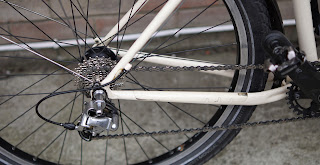Nonetheless, compact, mid power lights certainly have their place.
Clutter-phobic best/sunny day’s machines are the most obvious. These might not see dark, greasy, salty wet roads but often enjoy late summer playtimes, where dusk can sneak up on us. Blinkies are the obvious weapons of choice but dusk and beyond calls for something more potent. The sort that can be navigated by.
This Ravemen CR600 is a case in point, hence why it’s now adorning the Teenage Dream’s bars (although photographed on my fixed gear winter trainer). As the name implies, it pumps out a maximum of 600lumens and tapers down to 300, 150 and 50lumens, with two flashing modes for good measure. Now, in keeping with this genre of light, run times in the highest settings. 1hour 20 minutes or so, in this instance.
However, Ravemen lights have some particularly nice, innovative touches, including the ability to plug “power bank” type auxiliary supply to buy some more time, should the integral battery tank. Ravemen also offers a wired “remote” button for easy mode changes on the fly.
Even along pitch black lanes, 600 lumens provide decent presence but if your training run/commute involves navigating longer sections of unlit roads, 1000lumens would be my benchmark. Lumens are only part of the story though- lens and reflector quality are equally important. Ravemen LR500S Front Light is a prime example of this RAVEMEN LR500S FRONT LIGHT | cycling-not-racing (sevendaycyclist.com) .
Compact lights can also make good companions and backups for dynamo systems. Even with the K-Lite units, I like to have a blinky on the go and though problems with high-end, high-power dynamo systems are rare, should something unexpected happen, you’ve got backup. Besides, a little torch type model is useful for tackling punctures, diagnosing strange noises, rummaging through luggage etc. Models, such as Moon Meteor Vortex are less compact but have replaceable batteries .
This has two advantages, the most obvious being that the light isn’t necessarily bin fodder when the battery is. However, it also means you can carry a couple of fully charged spares and slip them in, to extend ride times. Prior to the Ravemen, I had been running the Moon Meteor.
A very discrete unit delivering 400 lumens in top but with a, attention-grabbing 500 lumen daylight flash. 400 lumens are more than adequate for those afternoons, or early mornings when dusk and dawn are en route and presence is called for. Talking of presence, I’ve been pleasantly surprised by the Brightside Bright, Amber & Sideways BRIGHTSIDE BRIGHT, AMBER & SIDEWAYS | cycling-not-racing (sevendaycyclist.com)
Look closely and you’ll notice I’ve pensioned off the Teenage Dream’s tri bar wrap in favour of the remnants of Velo Orange Rubbery bar Tape. Knew I’d find a use for it and in this instance, it was literally made to measure.
The Ritchey wrap had served faithfully for several years but was starting to look tired in places and I knew the Velo Orange would upgrade damping and grip. Not that I ride on the Tri Bars for extended distances and, but these Cinelli Mini Sub 8 Aero Extensions are suitably unobtrusive, while still offering decent shelter from the wind.
Talking of the Teenage Dream, it’s now 31 years since the original build and It marked my transition to adulthood, and mirroring myself, has evolved progressively since.
Aside from some fond memories of tractor racing and philosophising with friends on balmy summer rides (talking about women, essentially), I don’t reflect fondly on this period of my life, or the 90s, generally.
There were definite, tangible achievements, some lessons learned, and significant people met but equally, some very dark and austere times. There is nothing to be gained from living in the past. Learn from it, take only those of genuine significance and continue forward along the winding road.
















